Learning the friendly way
Dive into our resources, guides, and articles for all things money-related. Grow your financial confidence with our experts curated tips and articles for both experienced and new investors.
LATEST ARTICLEs
.svg)
Playing an important role in the adoption of Web3, Enjin provides a platform of software products designed to allow anyone to harness the power of NFTs (non-fungible tokens) through the development, trade, monetization, and marketing of blockchain assets.
The Enjin Coin (ENJ) is the native utility and governance token of the Enjin ecosystem. For gamers, developers and investors alike, ENJ matters because it bridges real-world value with digital goods, offering a means to turn in-game items into tradable assets. In this article you’ll learn what ENJ is, how it works, its key use-cases, how to buy it, its tokenomics, investment considerations and how it stacks up against other gaming tokens.
What Is the Enjin Platform?
The Enjin platform is an ecosystem of interconnected, blockchain-based gaming products designed for individuals, game developers and businesses to create, manage and trade virtual goods such as digital art, games, or virtual marketplaces using the Ethereum blockchain. Enjin aims to provide users with the tools to implement smart digital solutions for blockchain games within the gaming environment.
Through the platform's software development kits (SDKs) and APIs, users can build digital assets as well as seamlessly integrate them into their games and applications.
Under the Enjin umbrella is the Enjin Network, a community gaming platform that allows users to create websites, chat, and host virtual stores. Over the course of a decade, the Enjin platform has accumulated over 20 million users.
The ecosystem binds together gaming communities, game-asset markets and blockchain infrastructure. For example, a developer might create a limited edition in-game sword, mint it using ENJ as backing, list it on the marketplace, players trade it, and the underlying ENJ can be melted or reused. For developers, Enjin provides monetisation tools. For gamers, it provides ownership and portability of digital items.
Powering the ecosystem is the Enjin Coin (ENJ), a token used to back the value of NFTs and other assets minted on the platform. When an asset is minted it locks ENJ tokens into a smart contract and effectively removes the tokens from circulation.
It’s also worth noting that Witek Radomski, Enjin's co-founder and the brainchild behind the ERC-1155 Ethereum token standard, wrote the code for the first non-fungible token (NFT). By utilizing its cutting-edge technology, Enjin is revolutionizing the future of gaming and digital assets.
Who Created Enjin?
Enjin was originally founded in 2009 as a gaming community platform by Maxim Blagov and Witek Radomski. Blagov took on the responsibility of being CEO and in charge of the platform's creative direction while Radomski took on the role of CTO, leading the technical development of the platform's products.
Following Radomski's interest in Bitcoin in 2012, the platform explored incorporating blockchain technology into its business model and embraced the world of tokenized digital assets.
Radomski went on to write the ERC-1155 token standard in June 2018, a token standard used for minting both fungible, semi-fungible and non-fungible tokens using the Ethereum network. This token standard is a critical building block in the platform’s design.
In 2017, the Enjin platform launched an initial coin offering (ICO), raising $18.9 million through ENJ token sales. A year later the project went live and in September 2019, the Enjin Marketplace was launched.
How Does Enjin Work?
The primary goal of the Enjin network is to facilitate the management and storage of virtual goods for games, anything from in-game currencies to unique in-game items. So, how does Enjin work? The process of creating and destroying these tokens involves five steps:
- Purchase
Developers purchase Enjin Coin. - Minting
In-game items are designed and effectively minted with the appropriate amount of ENJ locked into a smart contract. - Utilization
Players use these tokens within the game. - Trading
Players trade the tokens between fellow players or on the internal or external marketplace. - Melting
Players sell the tokens for Enjin Coin, referred to as melting. The token is destroyed and Enjin Coin is released from the smart contract.
SDKs (software development kits) come into play here, with kits designed to fulfill certain functions, such as facilitating a payment platform or being wallet-focused. These kits are designed to minimize costs and simplify the process of creating these virtual goods. APIs (application programming interfaces) work alongside the SDKs to integrate these virtual goods (digital assets) into the game.
The Enjin platform utilizes JumpNet which is integrated with other products in the ecosystem, such as the Marketplace, Enjin Beam, and the Enjin Wallet to allow for gas-free transactions for ENJ and NFTs.
The Enjin ecosystem encompasses the Enjin smart wallet that allows players to store and trade their in-game items with ease. The Enjin wallet is designed to connect all the features, from managing inventory to conducting transactions and selling these tokenized digital assets for ENJ.
What is the Enjin Coin (ENJ)?
As we mentioned previously, Enjin Coin (ENJ) is the native token of the Enjin ecosystem. Built on the Ethereum blockchain and compatible with multiple gaming platforms, the Enjin Coin is an ERC-20 token that allows the in-game items created on the platform to be traded with real-world value. The ENJ token has a maximum supply of 1 billion coins.
The token also allows developers to mint these digital goods. The process requires the users to lock Enjin Coin (ENJ) into a smart contract that automatically assigns value to the in-game item. Players that later use these items can use them in the game, trade them or sell them for ENJ, equivalent to the original minting cost. Once sold, the item is destroyed (known as melting) and the ENJ that was locked in the smart contract is released to the seller.
How Can I Buy the Enjin Coin?
Anyone can tap into the Enjin ecosystem by acquiring ENJ tokens through the Tap mobile app. Simply create an account and complete the verification process in order to gain access to your unique Enjin wallet, from where you can buy, trade and sell Enjin Coin.
Fully licensed and regulated, Tap provides a secure and convenient means of managing your funds, allowing users to manage and store both crypto and fiat currencies in one location. With a wide range of supported currencies and services, Tap is revolutionizing the financial space.
Take advantage of the power of Enjin Coin on the Tap app - the ultimate platform to buy, sell or hold ENJ. With seamless integration and an intuitive interface, trading Enjin tokens has never been easier. Stay up-to-date with the latest market trends and keep your portfolio on track by monitoring the Enjin Coin price in real-time.
Bottom Line
Enjin Coin (ENJ) is more than just another cryptocurrency; it's the utility token powering a complete blockchain gaming ecosystem. It allows game studios to create, manage, and monetize digital assets, gives gamers true ownership and the ability to trade those assets, and offers investors exposure to where gaming, NFTs, and Web3 infrastructure converge.
That said, adoption rates, competition, and regulatory developments all play a role in ENJ’s future. If blockchain gaming, asset tokenization, and virtual economies interest you, ENJ presents a compelling option. Just make sure to do your research, evaluate the projects actually using it, and align any investment with your own goals and risk tolerance.
.webp)
Le phénomène memecoin, kesako
Dans l'univers coloré et souvent chaotique des cryptos, il existe un coin particulier dominé par ce qu'on appelle les "memecoins". Contrairement aux cryptos classiques qui se prennent au sérieux avec leur technologie sophistiquée, les memecoins jouent une tout autre partition. Pas de grands discours sur la révolution financière ici - ces cryptos surfent plutôt sur la vague du fun et de la culture web.
Malgré leur côté amusant, les memecoins sont souvent au cœur de manipulations de marché et d'autres arnaques, ce qui en fait de véritables montagnes russes. Leur volatilité est extrême, et les risques sont bien réels.
Alors, qu'est-ce qui attire tant de monde vers ces blagues numériques ? C'est simple : certains memecoins ont parfois offert des rendements astronomiques aux plus téméraires. Mais dans cette galaxie de memecoins, comment distinguer les vraies pépites des arnaques ? Voici quelques repères essentiels.
Qu'est-ce qui rend les memecoins si populaires ?
Les memecoins, comme le célèbre Dogecoin ou Shiba Inu, démarrent souvent comme des blagues. Ils sont davantage associés au divertissement qu'à l'utilité, et gagnent en popularité grâce à la force de leur communauté, aux réseaux sociaux et parfois aux soutiens de célébrités.
Contrairement aux cryptomonnaies traditionnelles comme Bitcoin ou Ethereum, les memecoins ne reposent généralement pas sur une technologie complexe ou des cas d'usage spécifiques. Leur objectif n'est pas de résoudre de grands défis technologiques mais plutôt de capturer l'esprit d'Internet sous forme de jetons. Leur valeur est donc principalement portée par l'enthousiasme collectif, le buzz en ligne et l'excitation de participer à un mouvement viral.
Les revers de la popularité
Récemment, les memecoins font beaucoup parler d'eux, suscitant une vague d'enthousiasme — et malheureusement, une recrudescence des arnaques. Pour naviguer dans ce secteur particulier du marché crypto, il faut avoir l'œil affûté. Avant de se lancer dans un memecoin, il est crucial d'examiner le projet, l'équipe qui le développe, sa feuille de route et sa transparence globale.
Les bons réflexes pour éviter les arnaques
Au-delà des blagues et du buzz
Si l'attrait initial d'un memecoin vient souvent de son humour, sa pérennité nécessite plus de substance. Recherchez des memecoins qui offrent une véritable utilité et un rôle dans un écosystème plus large — ce sont des signes d'un projet qui potentiellement peut durer.
La transparence avant tout
Méfiance quand tout est flou! Méfiez-vous des memecoins entourés de mystère, où les informations sur l'équipe et leurs mises à jour sont rares. Un projet de memecoin fiable communique ouvertement sur ses avancées et sur les personnes qui le dirigent.
La sécurité, c'est du sérieux
Les memecoins attirant souvent l'attention des pirates informatiques, une sécurité robuste est indispensable. Un memecoin crédible aura fait l'objet d'audits de sécurité rigoureux. L'absence de mesures de sécurité solides est un signal d'alarme.
Une communauté qui assure
Une communauté dynamique et active est cruciale pour le succès d'un memecoin. Les projets portés par leurs communautés ont tendance à avoir un avenir plus prometteur, s'épanouissant grâce au soutien collectif de leurs membres.
Conclusion
Les memecoins représentent un phénomène unique dans l'univers des cryptomonnaies, mêlant l'humour d'Internet au monde des actifs numériques. Qu'on en rie ou qu'on les prenne au sérieux, ils sont devenus une partie fascinante de l'histoire des cryptos. Entre les succès éclair et les arnaques bien ficelées, difficile parfois de s'y retrouver.
Cependant, les caractéristiques mêmes qui rendent les memecoins attractifs — leur nature virale et l'engouement communautaire — en font aussi un terrain propice aux bulles spéculatives et aux déboires financiers. Ce marché peu ou pas régulé et souvent imprévisible attire à la fois les opportunités et les arnaqueurs.
Pour les curieux et les passionnés, naviguer dans cet univers demande de rester informé, vigilant et perspicace. Comprendre ce qui différencie un véritable memecoin d'une arnaque est crucial. Il ne s'agit pas uniquement du buzz initial ou de l'humour, mais de bien d'autres éléments comme de la valeur sous-jacente, des mesures de sécurité, de la transparence et de l'engagement communautaire qui soutiennent la pérennité du projet.

Cryptocurrencies have gained a reputation for being largely volatile investments. While stocks too can have their moments (what with Peloton stocks dropping 20% every other day) the crypto market carries the brunt of it.
Thankfully, stablecoins have come to the rescue. While still functioning as digital currencies powered by blockchain technology, stablecoins are pegged to external assets such as fiat currencies or gold, thereby eradicating (most of) their volatility.
A Short History Of Stablecoins
After the advent of Bitcoin in 2009, it was only a few years later that a stable digital asset entered the market. Stablecoins came into existence in 2014 when a Hong-Kong based company named Tether Limited released a coin of the same name. The Tether coins' value was pegged to the US dollar, meaning that 1 USDT would always be worth $1.
In order to guarantee this value, the company held the dollar equivalent in bank accounts. Skip past the controversy surrounding their reserves and lack of financial analysis, and there are now plenty of other stablecoin options on the market.
Seeing the infinite benefits of digital currency transactions and blockchain technology, like speed, transparency and low fees, many companies around the world have created their own version of the stablecoin, mostly improving on the previous release. These coins have proven to be invaluable with businesses and retail merchants around the world.
Today, the two biggest stablecoins on the market are Tether (USDT) and USD Coin (USDC). One can argue whether these are "safe haven" assets, but one cannot deny that these tokens hold most of the advantages that digital currencies hold while considerably diminishing the unpredictable market swings.
In our attempt to better understand the concept, let's take a look at the two biggest stablecoins.
Tether (USDT) vs USD Coin (USDC)
Below we explore the two multi-billion-dollar market cap stablecoins, while they both provide the same service in terms of a digital currency, the companies behind them operate quite differently.
What Is Tether (USDT)?
As mentioned above, Tether is the first stablecoin to enter the market. Launched in 2014, the network was initially built on the Ethereum blockchain but is now compatible with a number of other networks.
Note that the Ethereum-based USDT cannot be traded as a TRON-based token, coins need to stick to their respective blockchain networks as this is how the transactions are processed.
It wasn't long before USDT was listed on the top exchanges, and included in dozens of trading pairs.
Tether Limited have since released a Euro-based stablecoin as well as Tether crypto coin pegged to the price of gold. The downside to Tether falls on the company's reputation surrounding transparency and reserve funds.
There have been several court cases where individuals and regulatory bodies have called for transparency surrounding the funds held in reserves. Tether has since provided access to this information but is yet to go through a third party audit. Regardless, Tether holds the third biggest market cap (at the time of writing).

What Is USDC (USD Coin)?
USD Coin is a stablecoin created by the Centre Consortium, an organisation made up of crypto trading platform Coinbase and Circle, a peer to peer payment platform. It launched in 2018 as an ERC-20 token and has since climbed the ranks to be in the top 5 biggest cryptocurrencies based on market cap. USD Coin is available on the Ethereum blockchain, as well as Solana, Polygon, Algorand and Binance Smart Chain networks.
The significant bonus that USDC holds over its biggest competitor, USDT, is that the coin is regularly audited by a third-party institution. These audits are made public, allowing any user to verify the authenticity of their USDC value each month. Since launching USDC, Coinbase has removed USDT from its platform.
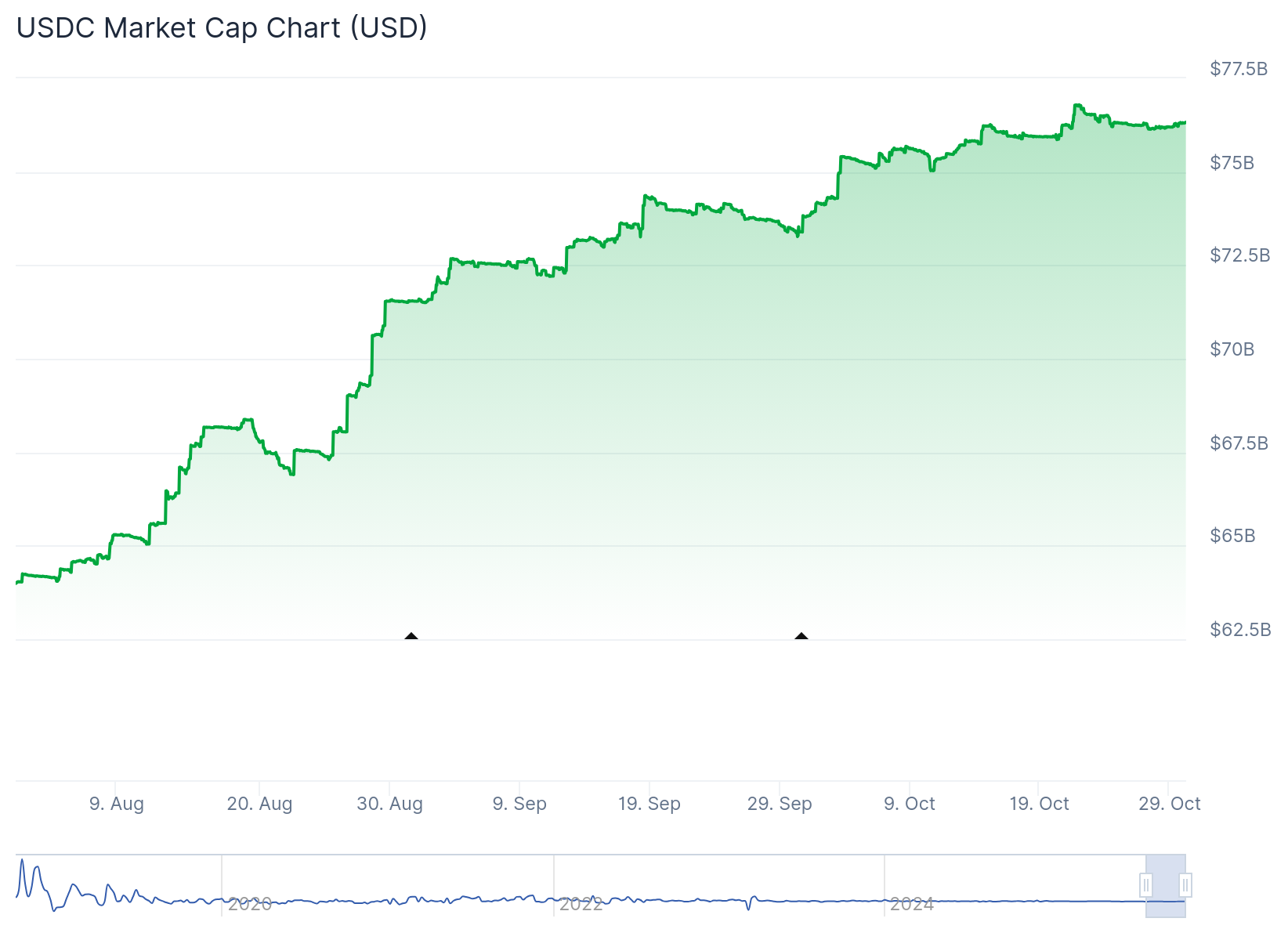
USDT vs USDC: Head-to-Head Comparison
Adoption
With over a decade in circulation, USDT has achieved far greater adoption worldwide. It remains the dominant stablecoin in trading pairs and global liquidity, particularly in emerging markets. Winner: USDT
Transparency
Tether has historically struggled with transparency, though it now publishes quarterly attestations. By contrast, USDC provides monthly reports with independent verification, giving it the edge for investors who value oversight and regulatory clarity. Winner: USDC
Regulatory Compliance
Circle and Coinbase designed USDC with U.S. and international regulations in mind. USDC reserves are kept in regulated banks and Treasuries, and Circle is registered as a money transmitter in multiple jurisdictions. Tether claims compliance but lacks comparable transparency. Winner: USDC
Price Stability
Both USDT and USDC are pegged 1:1 to the U.S. dollar. While they occasionally experience small deviations, both have shown resilience and quickly return to their peg. Winner: Tie
Redemption Process
Redeeming USDT directly requires a minimum of 100,000 USDT plus fees, which makes it impractical for small investors. USDC allows redemptions starting at just $100, giving it an accessibility advantage. Winner: USDC
Incidents
Both stablecoins have faced brief de-pegging events. USDT dipped below $0.95 during market stress in 2022, while USDC fell to around $0.87 during the Silicon Valley Bank crisis. In both cases, prices stabilized quickly. Winner: Tie
Longevity
Tether has been around since 2014, giving it a proven track record and first-mover advantage. Winner: USDT
Which Stablecoin Should You Choose?
Due to the fact that these respective companies are holding the dollar-equivalent value in reserves, these two digital currencies are considered to be centralized, while the rest of the cryptocurrency market holds a decentralized nature. As the demand for digital currencies increases, it is likely that these two stablecoins will only continue to grow.
When looking for a stablecoin, these are two most recognised options. Choosing between USDT and USDC depends on what you value most as an investor or user.
- If you need deep liquidity, global adoption, and access across more blockchains, USDT remains the go-to option. Its size and reach are unmatched, making it the default stablecoin for many traders.
- If you prioritize regulatory compliance, transparency, and a lower barrier for redemptions, USDC is the safer bet. It continues to build trust among institutions and investors who want accountability.
Ultimately, both stablecoins play vital roles in today’s crypto ecosystem. Some traders even use a combination of USDT and USDC to balance adoption with transparency, hedging against risks specific to either coin.
Users can both buy and sell USDT and USDC directly through the Tap app. Simply create your account, complete the KYC process and deposit funds into your digital wallet. Manage your entire crypto (and fiat) portfolio from one convenient, secure location.

2025 has been a defining year for AI. OpenAI’s GPT-5 and Anthropic’s Claude Sonnet 4.5 have raised the bar once again, each one aiming to blend stronger reasoning, longer memory, and more autonomy into one seamless system. Both are built to handle coding, research, writing, and enterprise-scale tasks, yet their design philosophies differ sharply.
This breakdown explores how the two stack up across performance, reasoning, coding, math, efficiency, and cost, helping users and teams decide where each model truly shines.
A Quick Overview
Claude Sonnet 4.5 builds on Anthropic’s refined Claude family. It extends memory across sessions, handles million-token contexts via Amazon Bedrock and Vertex AI, and features smart context management that prevents sudden cut-offs. It can run autonomously for 30 hours on extended tasks, making it ideal for ongoing workflows.
Meanwhile, GPT-5 is OpenAI’s flagship successor to GPT-4, tuned for agentic reasoning, where the model plans, executes, and coordinates tools on its own. Its adaptive reasoning system dynamically chooses between shallow or deep “thinking” paths, letting users balance speed, cost, and depth per task. GPT-5 also offers specialized variants (Mini, Nano) for lighter workloads.
Reasoning and Analysis
Both models far exceed their 2024 counterparts, but they differ in how they reason.
GPT-5’s deep-reasoning mode significantly boosts performance in multi-step logic, scientific, and spatial tasks. It can break problems into chains, test sub-hypotheses, and self-correct mid-process. However, disabling this mode reduces accuracy sharply, it can be brilliant when “thinking deeply,” but more variable when not.
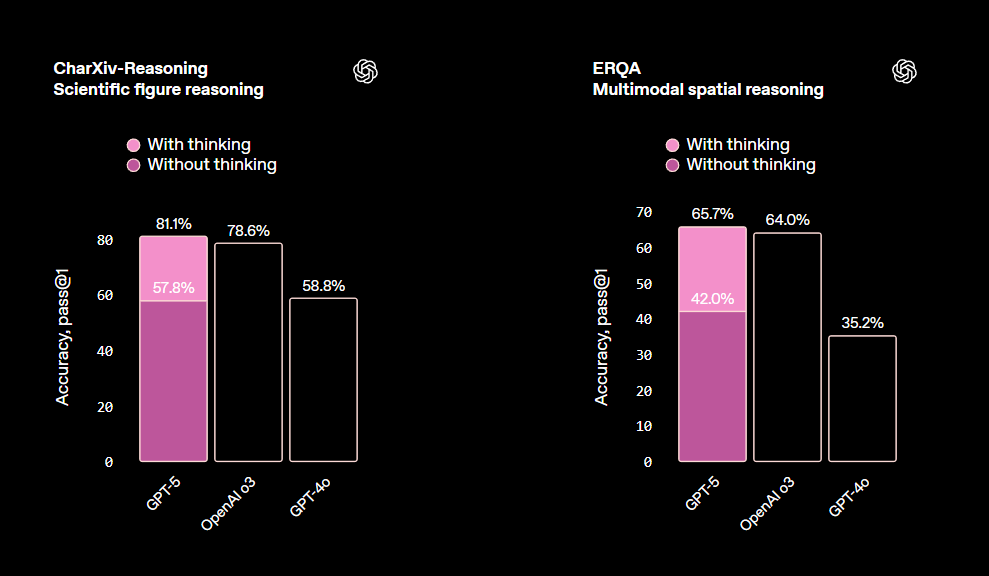
Claude Sonnet 4.5, by contrast, stays stable even without added configuration. It’s particularly strong in financial, policy, and business logic, where structure and coherence matter more than creative leaps. For enterprise Q&A or decision support, that predictability is valuable.

If you want an AI that reasons steadily, Claude takes the lead. If you need exploratory logic (i.e. complex hypothesis testing or cross-domain synthesis) GPT-5’s deeper path is unmatched.
Math and Structured Problem Solving
As seen in the benchmarks provided by Anthropic, Claude Sonnet 4.5 continues its consistency streak. Whether calculating directly or using Python tools, it achieves top-tier math accuracy. This means it handles structured logic even in constrained environments.
GPT-5 also reaches near-perfect accuracy, but only when tool use and reasoning depth are active. Disable them, and results drop noticeably. It relies heavily on its reasoning pipeline to stay sharp.
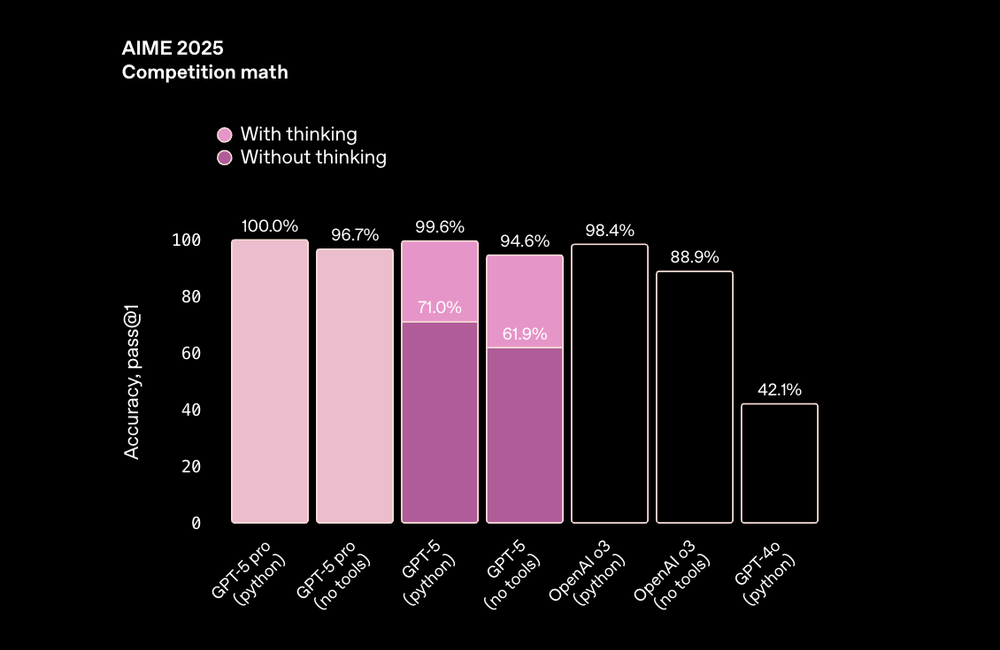
Verdict:
- Claude Sonnet 4.5: dependable out-of-the-box math solver.
- GPT-5: flexible but needs tuning to perform at its best.
Coding and Software Engineering
When it comes to coding, the two models diverge in style.
Claude Sonnet 4.5 delivers stable performance without special tuning. In tests resembling HumanEval+ and MBPP+, it maintains high accuracy across conditions, making it dependable for production pipelines. Its strength lies in consistency, results rarely fluctuate, which is crucial for enterprise use.

By contrast, GPT-5 achieves higher peak scores when its advanced reasoning is enabled, especially in multi-language or large-project contexts. In JavaScript and Python refactoring tasks, for instance, it outperformed Sonnet when its “high-reasoning” mode was active — though baseline runs without that mode varied more.
For agentic coding, where the AI calls external tools or terminals, Sonnet 4.5 often executes with fewer dropped commands. GPT-5, on the other hand, can chain more tool calls simultaneously, making it better for complex orchestration, provided you configure it carefully.
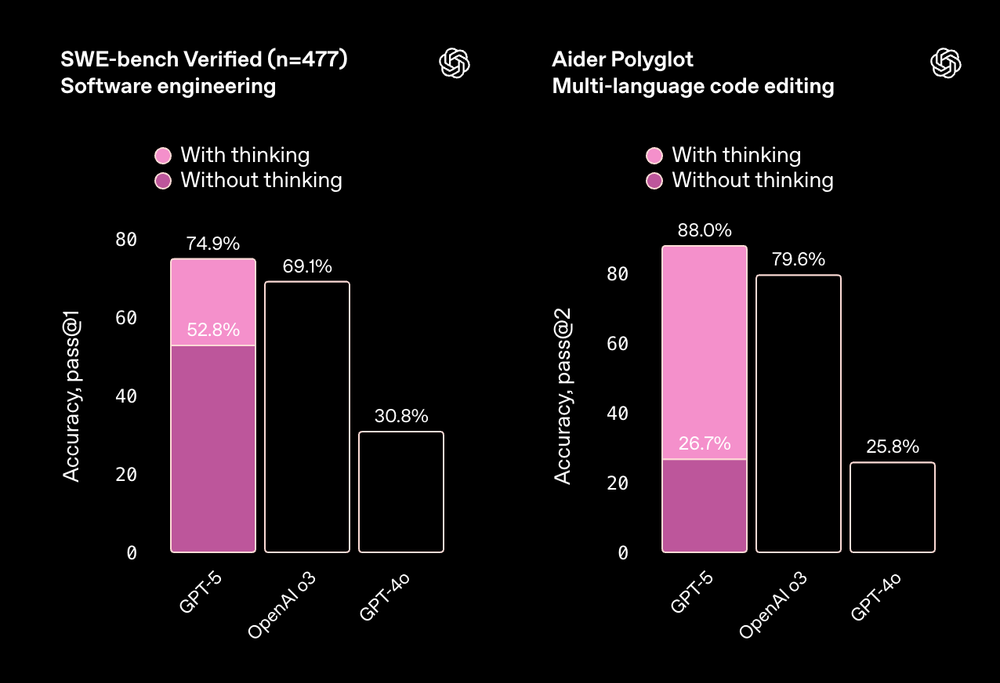
Verdict:
- Claude Sonnet 4.5: predictable, steady engineering partner.
- GPT-5: versatile powerhouse, but performance hinges on setup.
Cost and Efficiency
GPT-5 is clearly cheaper per token, particularly for large inputs. Its adaptive router also saves compute by running simple prompts on lighter paths.
Claude Sonnet 4.5 charges more but maintains predictable latency, a key factor for production environments that value reliability over marginal savings. For very large prompts, its cost rises faster than GPT-5’s, though batch discounts narrow the gap.
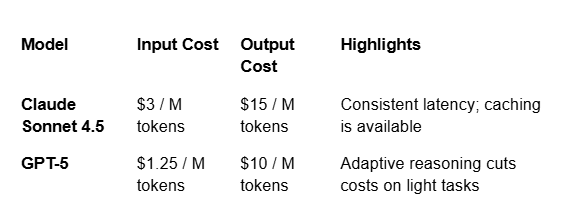
TL;DR: GPT-5 wins on price and scalability, whereas Claude wins on timing consistency and stability.
Pricing for Premium Plans
Beyond API access, both OpenAI and Anthropic offer premium subscriptions for individual users, which differ in features and pricing.
ChatGPT Plus, powered by GPT-5, is priced at $20 per month, giving users priority access to GPT-5, faster response times, and early access to new features and memory. OpenAI’s unified ChatGPT experience also includes file uploads, image generation, and custom GPTs.
Claude Pro, meanwhile, costs $20 per month as well and grants access to Claude Sonnet 4.5, offering faster responses, higher rate limits, and longer context windows. While it lacks built-in multimodal tools, Claude focuses on text clarity and structured reasoning, appealing to researchers, analysts, and writers seeking dependability over versatility.
TL;DR: both Plus plans are tied in price; what sets them apart, however, is their offering.
Different Strengths for Different Needs
It’s tempting to crown one “best,” but GPT-5 and Claude Sonnet 4.5 serve different priorities for different users and teams.
- Claude Sonnet 4.5: best for reliability and sustained performance. If you want consistent outputs and clear memory behavior, Claude delivers.
- GPT-5: best for depth, flexibility, and scalability. When configured properly, it surpasses rivals in creative reasoning, multimodal integration, and adaptive tool use.
Most teams may find the strongest setup is multi-model, using Claude where consistency matters most, and GPT-5 for data-intensive workflows.
Ultimately, these aren’t just chatbots anymore, they’re full-fledged digital collaborators, each with distinct personalities. Claude Sonnet 4.5 is your calm, methodical analyst. GPT-5 is your ambitious polymath. Which one you pick depends less on their individual benchmarks and more on your mission.

Tap est une plateforme fintech qui fusionne la finance traditionnelle avec la cryptomonnaie. Lancée en 2019, elle offre une large gamme d'outils et de fonctionnalités financières. Le tokenXTP débloque des services premium et des récompenses, améliorant davantage l'expérience Tap.
Tap (XTP) est une plateforme de technologie financière pionnière établie en 2019, révolutionnant la finance en fusionnant la banque traditionnelle avec la gestion des cryptomonnaies. Elle facilite les transferts d'argent instantanés et gratuits au sein de son réseau, incitant sa communauté et simplifiant le partage des factures et des dépenses. Tap vise à démocratiser la finance et à donner aux individus les moyens d'utiliser des outils financiers complets, offrant des interfaces intuitives, des fonctionnalités puissantes et des mesures de sécurité robustes.
Qu'est-ce que Tap (XTP) ?
Gérer de l'argent sur différentes plateformes et devises peut être une tâche intimidante dans le monde numérique d'aujourd'hui. Tap (XTP) émerge comme une solution fintech révolutionnaire, comblant le fossé entre la finance traditionnelle et les cryptomonnaies. Établie en 2019, cette application innovante s'est donné pour mission de démocratiser la finance et de donner aux utilisateurs les moyens d'utiliser des outils financiers complets.
Ce qui distingue Tap, c'est sa capacité à fournir un écosystème tout-en-un où vous pouvez envoyer et recevoir de l'argent ou des cryptomonnaies instantanément et sans frais au sein de son réseau Tap2Tap, payer des factures et investir dans une gamme de cryptomonnaies. Tap offre également une rampe d'accès facile pour convertir la monnaie fiduciaire en actifs numériques et des services de sortie pour encaisser à faibles frais. Plus besoin de jongler avec plusieurs applications ou de s'inquiéter des frais internationaux lors de voyages à l'étranger.
Le token XTP, la cryptomonnaie native ERC-20 de Tap, est la clé qui débloque tout le potentiel de cette plateforme. Utilisez XTP pour accéder à des fonctionnalités premium comme jusqu'à 8% de cashback sur les dépenses, gagner des récompenses et obtenir l'accès à des services exclusifs au sein de l'écosystème Tap. Avec sa Mastercard intégrée, vous pouvez dépenser sans effort vos fonds et gagner du Cashback chez des millions de commerçants dans le monde.
Propulsé par des mesures de sécurité robustes, la conformité réglementaire et une interface conviviale, Tap offre un parcours financier sûr et transparent, adapté au consommateur moderne.
Présentation de la fonctionnalité de Tap
Tap est une plateforme financière complète qui combine harmonieusement les comptes monétaires traditionnels et la gestion des cryptomonnaies, offrant aux utilisateurs une plateforme centralisée pour toutes leurs transactions monétaires. Son cœur est une application mobile qui sert d'interface principale pour accéder aux services de Tap.
Avant d'y accéder, les utilisateurs doivent passer par un processus de vérification qui implique de fournir des informations personnelles pour se conformer aux réglementations Know Your Customer (KYC) et Anti-Money Laundering (AML). Une fois vérifiée, l'application conviviale leur permet d'acheter, de vendre et de stocker en toute sécurité une gamme diversifiée de cryptomonnaies - actuellement près de 50 options différentes.
L'application simplifie le processus d'acquisition de cryptomonnaies en acceptant diverses méthodes de paiement, y compris les cartes de débit et les virements bancaires. Les utilisateurs peuvent également transférer des cryptomonnaies de leurs portefeuilles externes vers leur compte Tap ou vendre leurs avoirs et transférer de la monnaie fiduciaire directement sur leurs comptes bancaires. Alternativement, les utilisateurs peuvent aussi envoyer des cryptomonnaies vers d'autres portefeuilles ou échanges. Le système de portefeuille de Tap est conçu avec des mesures de sécurité robustes et des capacités de chiffrement, assurant la sauvegarde des actifs des utilisateurs.
Pour dépenser facilement les cryptomonnaies, les utilisateurs peuvent commander une Mastercard Tap - disponible sous forme physique et virtuelle - directement via l'application. Pour utiliser la carte pour des achats, ils peuvent la précharger directement depuis leur portefeuille Tap. La carte permet également des retraits d'espèces aux distributeurs automatiques dans le monde entier et offre un généreux Cashback allant jusqu'à 8%, selon le niveau de l'utilisateur. De plus, la carte offre d'excellents taux de conversion FX, permettant à ses utilisateurs de dépenser a l'international sans souci.
Qu'est-ce qui rend Tap unique ?
Oubliez la jonglerie entre plusieurs applications et comptes. Tap fusionne harmonieusement les comptes monétaires traditionnels avec les cryptomonnaies de pointe, le tout sur une plateforme intuitive. Convertissez instantanément vos actifs numériques en espèces pour une utilisation quotidienne ou développez votre portefeuille avec une large gamme de cryptomonnaies prises en charge. C'est le meilleur des deux mondes.
Ce qui distingue vraiment Tap, c'est sa capacité à convertir instantanément les cryptomonnaies en monnaie fiduciaire grâce à sa fonction de rampe d'accès et de sortie. Plus besoin d'attendre ou de gérer des processus compliqués. Cette fonctionnalité est pratique pour les utilisateurs souhaitant intégrer les cryptomonnaies dans leurs transactions quotidiennes, car elle élimine le délai habituel associé aux conversions crypto-fiat.
Le large éventail de cryptomonnaies prises en charge par Tap offre aux utilisateurs la flexibilité de stocker, gérer et échanger un portefeuille diversifié, le tout à partir d'une seule plateforme. Ce large support en fait une application incontournable pour les passionnés de cryptomonnaies.
Qu'est-ce que l'écosystème Tap ?
L'écosystème Tap incarne une suite complète de services financiers et de fonctionnalités visant à offrir une interface fluide pour la gestion des avoirs en monnaie fiduciaire et en cryptomonnaies.
Voici une liste des différentes fonctionnalités qu'il offre :
Portefeuille multi-devises :
Tap propose un portefeuille numérique sécurisé et crypté qui prend en charge plus de 50 cryptomonnaies différentes. Ce portefeuille permet aux utilisateurs de stocker, gérer et basculer facilement entre diverses crypto et monnaies fiduciaires, répondant à la fois aux besoins d'investissement et de transactions quotidiennes.
Échange de cryptomonnaies :
Les utilisateurs peuvent échanger une large et diverse gamme de cryptomonnaies. Contrairement à d'autres plateformes avec des paires limitées, Tap permet aux utilisateurs d'échanger n'importe quel actif contre un autre sans contraintes. Ce processus sans tracas garantit flexibilité et facilité d'utilisation. De plus, la plateforme de trading privilégie la rapidité et l'efficacité, offrant une expérience fiable et conviviale à tous les utilisateurs.
La carte Tap :
Un composant essentiel de l'écosystème Tap est sa Mastercard prépayée, permettant aux utilisateurs de dépenser et retirer de l'argent dans le monde entier.
Le Cashback :
Une caractéristique marquante des offres de Tap est son programme de Cashback, offrant des récompenses à tous les utilisateurs qui utilisent leur carte. En effectuant une mise à niveau, les utilisateurs peuvent débloquer encore plus d'avantages, gagnant jusqu'à 8% de Cashback sur leurs achats avec la carte Tap.
Transferts d'argent instantanés :
Tap permet des transferts d'argent rapides et gratuits dans le monde entier via son réseau Tap2Tap, permettant aux utilisateurs d'envoyer des cryptos à d'autres utilisateurs Tap au sein de l'application sans frais supplémentaires.
Support de monnaie fiduciaire :
En plus de ses services crypto, Tap prend également en charge diverses monnaies fiduciaires, permettant aux utilisateurs de gérer la monnaie traditionnelle aux côtés de leurs actifs numériques.
Outils d'investissement et de trading :
Tap fournit aux utilisateurs une gamme d'outils et de fonctionnalités, y compris un routeur de trading intelligent, une newsletter de marché et un suivi des prix en temps réel.
Routeur de trading intelligent :
Le routeur intelligent de pointe localise le meilleur lieu d'exécution en scannant plusieurs bourses et fournisseurs de liquidité en temps réel, pour trouver le meilleur prix disponible qu'il peut localiser pour leurs achats.
Qu'est-ce que le token XTP ?
Le token XTP sert plusieurs objectifs au sein de la plateforme Tap. Principalement, il facilite le trading en réduisant les frais de transaction et en permettant aux utilisateurs d'accéder à divers plans premium, chacun offrant une large gamme d'avantages. Les utilisateurs peuvent également échanger XTP contre de nombreuses cryptomonnaies répertoriées sur la plateforme, grâce à la disponibilité de multiples paires de trading XTP. Cette flexibilité permet aux utilisateurs de diversifier facilement leurs portefeuilles d'actifs numériques.
En utilisant le token XTP, les utilisateurs peuvent passer à des plans premium qui offrent des avantages tels que jusqu'à 8% de Cashback, des frais de trading réduits, des frais FX diminués, des limites de dépenses de carte plus élevées, des newsletters de marché exclusives et un support premium au sein de l'application. De plus, Tap facilite les transferts rapides et gratuits de token XTP entre les comptes Tap, offrant une solution fluide pour les transferts d'actifs mondiaux. Cette fonctionnalité est particulièrement précieuse pour les personnes recherchant des méthodes efficaces et rentables pour transférer des fonds à travers les frontières.
L'application bien réglementée et sécurisée de Tap assure une expérience de trading fluide, répondant aux besoins uniques de chaque utilisateur. De plus, la plateforme fournit un portefeuille sécurisé pour le stockage sûr des token XTP, offrant tranquillité d'esprit et gestion rationalisée des actifs pour les utilisateurs.
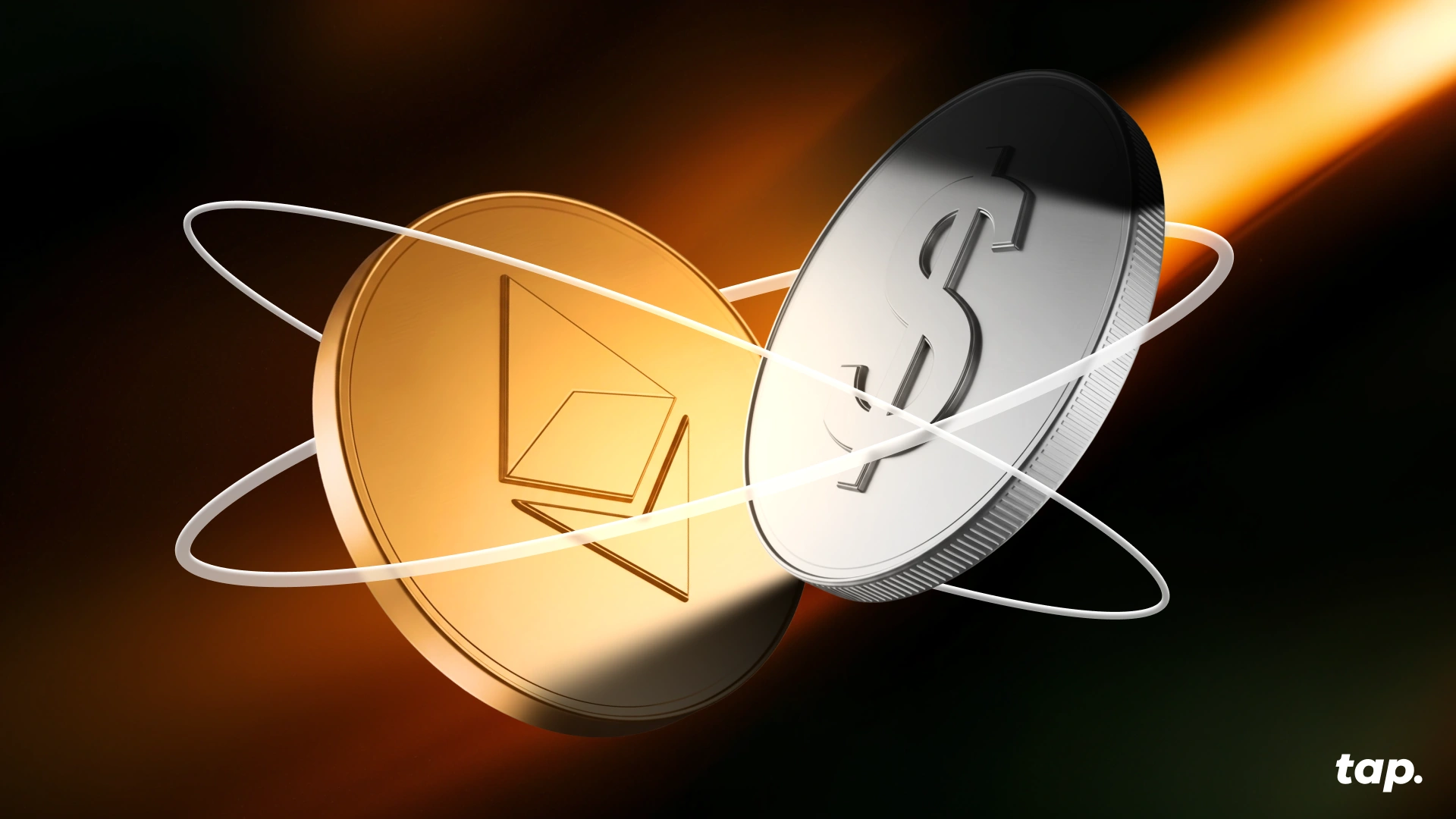
What Are Fiat On-Ramps and Off-Ramps?
For many users, one of the biggest challenges in the crypto space is figuring out how to move between traditional money and digital currencies safely and easily. That’s where fiat on-ramps and off-ramps come in. These essential gateways allow users to convert their local currency (like US dollars, GB pounds, or euros) into crypto and back again, helping bridge two financial worlds.
In this guide, we’ll break down what each type of ramp means, how they work, and why they’re critical for expanding real-world crypto adoption.
What Is a Fiat On-Ramp?
A fiat on-ramp is a service that lets users buy cryptocurrencies using traditional fiat currencies such as USD, EUR, or GBP. In other words, it’s the entry point into the world of crypto. Exchanges, brokerage platforms, and payment services act as intermediaries, processing financial transactions and converting fiat money into assets like Bitcoin, Ethereum, or stablecoins.
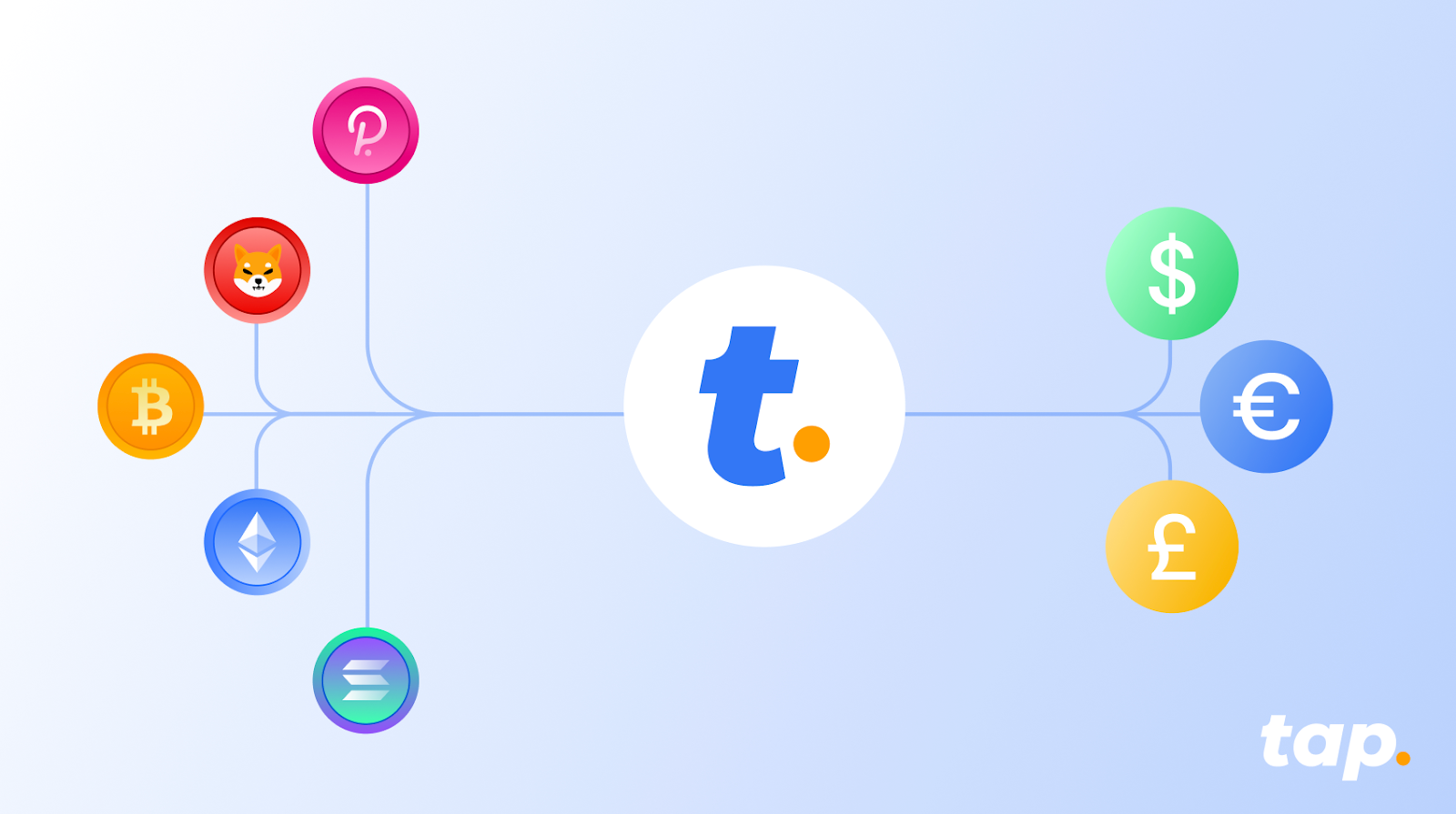
Common examples include centralized exchanges or fintech apps that integrate blockchain functionality. On-ramps are regulated financial services that typically require Know Your Customer (KYC) verification to comply with laws on anti-money laundering and consumer protection.
When choosing a fiat on-ramp, users should evaluate fees, supported currencies, and security standards to ensure a smooth and safe experience.
The Advantages and Disadvantages of Fiat On-Ramps
Fiat on-ramps make entering the crypto market much easier, particularly for beginners. They simplify the process of buying digital assets without requiring technical expertise.
They also open the door to a diverse set of cryptocurrencies, letting users explore different projects and blockchain networks. Some on-ramps even offer instant payment methods through debit or credit cards, wire transfers, or mobile apps like Google Pay, enabling fast transactions and greater convenience.
From a business perspective, on-ramps support financial inclusion by connecting traditional banking systems to blockchain-based platforms, driving mainstream adoption and innovation across the fintech industry.
While fiat on-ramps are convenient, they also come with a few challenges. Users must comply with verification and regulatory requirements, which can take time. Another potential issue is exposure to fraudulent or unlicensed platforms, which can compromise data or funds. To minimize these risks, users should choose on-ramps that offer transparent pricing and operate in full compliance with financial regulations, like Tap.
In addition, on-ramps might charge higher transaction or processing fees, especially for card purchases or smaller amounts. To keep fees low and help users get the best crypto deals without platform hopping, Tap uses a top-of-the-line smart router.
What Is a Fiat Off-Ramp?
A fiat off-ramp performs the opposite function: it lets users sell cryptocurrency and receive fiat money in their bank account. Off-ramps provide liquidity and help people turn crypto assets into spendable cash.
Off-ramps operate through centralized exchanges, peer-to-peer platforms, or crypto debit cards that automatically convert digital assets into fiat currency at the point of sale. This process makes cryptocurrencies more practical for daily use, enabling real-world purchases, payments, and withdrawals.
How Fiat Off-Ramps Work
The off-ramping process generally involves a few simple steps:
- Transfer crypto from your wallet to an exchange or service that supports fiat withdrawals.
- Sell or convert your chosen cryptocurrency into your preferred fiat currency.
- Withdraw funds to your linked bank account or payment method (for example, a debit card).
Processing times vary by provider and banking network, usually ranging from a few minutes to a few business days. Many platforms require identity verification to meet anti-fraud and regulatory standards. Key factors influencing the experience include withdrawal limits, transaction fees, and the fiat currencies supported.
The Advantages and Disadvantages of Fiat Off-Ramps
The main advantage of off-ramping is, of course, liquidity: the ability to convert digital currencies into usable cash when needed. Whether users want to pay bills, make everyday purchases, or take profits from crypto investments, off-ramping makes that possible.
It also provides flexibility in managing risk. When markets are volatile, selling crypto for fiat can help stabilize personal finances. Additionally, off-ramping plays a role in promoting transparency and regulatory compliance by ensuring that transactions are traceable and aligned with local laws.
Off-ramping faces similar challenges to on-ramping, including variable fees, conversion delays, and regulatory hurdles. Some banks restrict transactions related to cryptocurrency exchanges, causing delays or rejections. Others may require additional verification steps for large transfers.
Users should check whether a platform offers low-cost conversions, and has clear customer support channels. As always, verifying a provider’s regulatory compliance and reputation helps avoid potential issues.
The Connection Between Fiat On-Ramps and Off-Ramps
Together, fiat on-ramps and off-ramps form the foundation of the crypto-fiat ecosystem. They create a two-way bridge that connects digital currencies to the traditional financial system, improving liquidity, usability, and accessibility.
Seamless on-ramping attracts new users by making it easy to enter the market, while efficient off-ramping gives confidence that assets can be converted back to fiat when needed. This balance is what enables broader adoption of cryptocurrencies across businesses, consumers, and financial services.
Platforms like Tap exemplify this connection by offering both on-ramp and off-ramp capabilities through secure infrastructure, compliance with financial regulations, and support for multiple digital assets. Users can buy, sell, and transfer between crypto and fiat currencies using a single account, without needing multiple intermediaries.
Security and Best Practices
Security should always come first when using any financial platform. Here are a few best practices:
- Verify regulation. Check whether the platform follows financial authority standards and offers transparent reporting.
- Use two-factor authentication. This adds an extra layer of protection to your account.
- Confirm wallet and withdrawal addresses. Mistyped addresses are one of the most common causes of lost funds.
- Start with small transactions. Test the service before transferring large amounts.
- Keep records. Store transaction data securely for personal reference or tax reporting.
Following these measures helps maintain data integrity and protects against common cyber risks in digital finance.
Common Challenges and How to Overcome Them
Here are a few recurring challenges users may face:
- Banking restrictions on crypto-related transactions.
- High conversion fees that can reduce profit margins.
- Processing delays during peak trading hours.
- Strict verification procedures that slow onboarding.
The best way to overcome these obstacles is to work with reputable, user-friendly well-established providers that maintain transparent communication and have strong partnerships with trusted financial institutions, such as Tap.
In Conclusion
Now that we've explored what a fiat on-ramp and off-ramp are, it becomes clear how essential it is for cryptocurrency users and investors to understand these processes as they provide liquidity, investment opportunities, and the ability to realize profits (in fiat currency).
Looking ahead, the future of fiat on-ramps and off-ramps appears promising. As the cryptocurrency landscape continues to evolve, we can anticipate exciting advancements in these gateways, making crypto assets more accessible and further driving their adoption into mainstream use.
TAP'S NEWS AND UPDATES
What’s a Rich Text element?
What’s a Rich Text element?The rich text element allows you to create and format headings, paragraphs, blockquotes, images, and video all in one place instead of having to add and format them individually. Just double-click and easily create content.
The rich text element allows you to create and format headings, paragraphs, blockquotes, images, and video all in one place instead of having to add and format them individually. Just double-click and easily create content.Static and dynamic content editing
Static and dynamic content editingA rich text element can be used with static or dynamic content. For static content, just drop it into any page and begin editing. For dynamic content, add a rich text field to any collection and then connect a rich text element to that field in the settings panel. Voila!
A rich text element can be used with static or dynamic content. For static content, just drop it into any page and begin editing. For dynamic content, add a rich text field to any collection and then connect a rich text element to that field in the settings panel. Voila!How to customize formatting for each rich text
How to customize formatting for each rich textHeadings, paragraphs, blockquotes, figures, images, and figure captions can all be styled after a class is added to the rich text element using the "When inside of" nested selector system.
Headings, paragraphs, blockquotes, figures, images, and figure captions can all be styled after a class is added to the rich text element using the "When inside of" nested selector system.What’s a Rich Text element?
What’s a Rich Text element?The rich text element allows you to create and format headings, paragraphs, blockquotes, images, and video all in one place instead of having to add and format them individually. Just double-click and easily create content.
The rich text element allows you to create and format headings, paragraphs, blockquotes, images, and video all in one place instead of having to add and format them individually. Just double-click and easily create content.Static and dynamic content editing
Static and dynamic content editingA rich text element can be used with static or dynamic content. For static content, just drop it into any page and begin editing. For dynamic content, add a rich text field to any collection and then connect a rich text element to that field in the settings panel. Voila!
A rich text element can be used with static or dynamic content. For static content, just drop it into any page and begin editing. For dynamic content, add a rich text field to any collection and then connect a rich text element to that field in the settings panel. Voila!How to customize formatting for each rich text
How to customize formatting for each rich textHeadings, paragraphs, blockquotes, figures, images, and figure captions can all be styled after a class is added to the rich text element using the "When inside of" nested selector system.
Headings, paragraphs, blockquotes, figures, images, and figure captions can all be styled after a class is added to the rich text element using the "When inside of" nested selector system.What’s a Rich Text element?
What’s a Rich Text element?The rich text element allows you to create and format headings, paragraphs, blockquotes, images, and video all in one place instead of having to add and format them individually. Just double-click and easily create content.
The rich text element allows you to create and format headings, paragraphs, blockquotes, images, and video all in one place instead of having to add and format them individually. Just double-click and easily create content.Static and dynamic content editing
Static and dynamic content editingA rich text element can be used with static or dynamic content. For static content, just drop it into any page and begin editing. For dynamic content, add a rich text field to any collection and then connect a rich text element to that field in the settings panel. Voila!
A rich text element can be used with static or dynamic content. For static content, just drop it into any page and begin editing. For dynamic content, add a rich text field to any collection and then connect a rich text element to that field in the settings panel. Voila!How to customize formatting for each rich text
How to customize formatting for each rich textHeadings, paragraphs, blockquotes, figures, images, and figure captions can all be styled after a class is added to the rich text element using the "When inside of" nested selector system.
Headings, paragraphs, blockquotes, figures, images, and figure captions can all be styled after a class is added to the rich text element using the "When inside of" nested selector system.
Say goodbye to low-balance stress! Auto Top-Up keeps your Tap card always ready, automatically topping up with fiat or crypto. Set it once, and you're good to go!
Read moreWhat’s a Rich Text element?
What’s a Rich Text element?The rich text element allows you to create and format headings, paragraphs, blockquotes, images, and video all in one place instead of having to add and format them individually. Just double-click and easily create content.
The rich text element allows you to create and format headings, paragraphs, blockquotes, images, and video all in one place instead of having to add and format them individually. Just double-click and easily create content.Static and dynamic content editing
Static and dynamic content editingA rich text element can be used with static or dynamic content. For static content, just drop it into any page and begin editing. For dynamic content, add a rich text field to any collection and then connect a rich text element to that field in the settings panel. Voila!
A rich text element can be used with static or dynamic content. For static content, just drop it into any page and begin editing. For dynamic content, add a rich text field to any collection and then connect a rich text element to that field in the settings panel. Voila!How to customize formatting for each rich text
How to customize formatting for each rich textHeadings, paragraphs, blockquotes, figures, images, and figure captions can all be styled after a class is added to the rich text element using the "When inside of" nested selector system.
Headings, paragraphs, blockquotes, figures, images, and figure captions can all be styled after a class is added to the rich text element using the "When inside of" nested selector system.BOOSTEZ VOS FINANCES
Prêt à passer à l’action ? Rejoignez celles et ceux qui prennent une longueur d’avance. Débloquez de nouvelles opportunités et commencez à façonner votre avenir financier.
Commencer







